|
|
|
Sort Order |
|
|
|
Items / Page
|
|
|
|
|
|
|
| Srl | Item |
| 1 |
ID:
120026
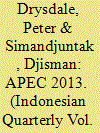

|
|
|
| 2 |
ID:
124561


|
|
|
|
|
| Publication |
2013.
|
| Summary/Abstract |
This study employs spatial panel techniques to examine determinants of regional allocation of infrastructure investment made by the central government. Using a sample of 31 Chinese provinces over the 2001-2008 period, we derived four major empirical findings. First, there exist substantial spatial interactions of central government's investment across regions. Second, the central investment exhibits a highly persistent effect. Third, the central government attempts to balance equity and efficiency in its decision-making. Last, the political factor plays a significant role in the regional infrastructure investment.
|
|
|
|
|
|
|
|
|
|
|
|
|
|
|
|
| 3 |
ID:
174654


|
|
|
|
|
| Summary/Abstract |
Powerful states often use tools of economic statecraft, such as foreign aid and other financial policy instruments, in a bid to “purchase” influence as well as establish regional leadership among their neighbors. How and why do these states undertake similar economic statecraft strategies and policies? The article examines the evolution of infrastructure financing policy of China and Japan and identifies the ever changing and, yet at the same time, mirroring interaction between the two countries’ development finance practices. We argue that emulation and competition have led to the process of policy diffusion between these two countries. The competition between these two foreign aid leaders in East Asia especially after China’s Belt and Road Initiative has shaped the region’s infrastructure development dynamics as they strive to move the equilibrium outcome to their advantage. Such equilibrium through the policy diffusion process has important implications on global development governance.
|
|
|
|
|
|
|
|
|
|
|
|
|
|
|
|
| 4 |
ID:
178809


|
|
|
|
|
| Summary/Abstract |
The paper investigates investments in gas infrastructure considering uncertainties in European gas markets. Furthermore, the study addresses the question of whether (more) diversification provides a (better) security of supply improvement. Thus, a stochastic optimization approach is introduced. The uncertainties focus on 2030 and 2045 in three dimensions, namely the Ukraine gas transit, future LNG prices, and the expected gas demand. Considering three diversification strategies, the model GAMAMOD-EU.sto optimizes investments in pipelines, LNG import terminals and gas storages as well as the gas dispatch. Results illustrate trade-offs between optimal gas supply and diversification strategies. Investments in pipelines to North African suppliers are made across all strategies, while the building of the Nord Stream 2 pipeline depend on the respective diversification strategy. Diversification through LNG quota changes the dispatch results significantly. Investments in storages are almost not necessary over all strategies, however, storages provide flexibility to prevent supply shortages, when diversification strategies are applied. Conclusion for policy makers regarding what is needed for preventing malinvestments and high costs in the European gas market are: an enhanced relationship between Russia and the EU and a clear vision on the role of gas in the future European energy system that reduces demand uncertainty.
|
|
|
|
|
|
|
|
|
|
|
|
|
|
|
|
| 5 |
ID:
171888


|
|
|
|
|
| Summary/Abstract |
China has started to deploy its Belt and Road Initiative (BRI) in the European Union (EU), and the EU in turn has regional and global interests that intersect with the BRI’s scope. Subject to future adjustments of China’s BRI strategy, the initiative’s potential contribution to the EU requirements for infrastructure development could be signicant, even though its modalities in the EU are inevitably different from those in countries that are poorer or have more difficult financial market access. The EU’s attitude to the BRI, however, has not yet fully coalesced. Despite supercial similarities in public discourses, the EU has a profoundly distinct perspective from that of the US on the BRI, and more generally on the rise of China and its growing global inuence. For the EU, the BRI generates challenges but also potential benets. The EU should improve its ability to welcome sensible BRI projects, including through the adoption of greater reform of screening frameworks for foreign direct investment. More generally, the EU should enhance its ability to define policies independent of the US on China and the challenges resulting from China’s rise. China should also make further efforts to foster a constructive relationship with the EU.
|
|
|
|
|
|
|
|
|
|
|
|
|
|
|
|
| 6 |
ID:
092264
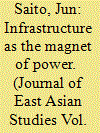

|
|
|
|
|
| Publication |
2009.
|
| Summary/Abstract |
By examining party-switching decisions among members of Japan's Liberal Democratic Party (LDP), this article shows how distributive policy programs exclusively available to the governing party attract incumbents to the party in power. In a stable electoral environment where the government party is likely to stay in power, legislators elected from infrastructure-poor constituencies are effectively tied to the party. However, when the party's electoral prospects are uncertain, legislators behave more sincerely and switch parties to match their policy preferences. It is also found that defectors elected from infrastructure-poor constituencies tended to return to the LDP once the party installed a stable surplus coalition.
|
|
|
|
|
|
|
|
|
|
|
|
|
|
|
|
| 7 |
ID:
086698
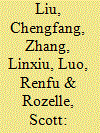

|
|
|
|
|
| Publication |
2009.
|
| Summary/Abstract |
Although quality may be as important as quantity in public infrastructure management, little research has studied changes in the quality of China's infrastructure investments. This study seeks to document the quality of infrastructure projects in China's villages and to measure whether or not quality has suffered as China's investment effort has risen. The study also examines if satisfaction is rising. Using data from 100 villages in China, we have found that both the quantity and the quality of infrastructure investments have increased. We also find that rural residents are more satisfied with projects, especially when they are higher quality.
|
|
|
|
|
|
|
|
|
|
|
|
|
|
|
|
| 8 |
ID:
190658
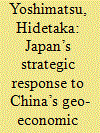

|
|
|
|
|
| Summary/Abstract |
In the new millennium, Japan found a renewed interest in infrastructure investment and engaged in this policy issue with diplomatic initiatives and external partnerships with due attention to China’s geo-economic presence. In formulating strategies for infrastructure investment, Japan has presented and disseminated a specific idea of ‘quality infrastructure’ as a principal component of its external infrastructure push. This article seeks to trace the evolution of Japan’s ideational principles for quality infrastructure and elucidate policy motivation, policy objective, and external influence. It argues that Japan’s advocacy of quality infrastructure derived from domestic impetus to expand infrastructure exports and external impetus to compete against China’s infrastructural push through the Belt and Road Initiative (BRI). Japan advocated quality infrastructure as a strategic tool to pursue multiple policy objectives that shifted from justifying Japanese infrastructural push to using as means to check and accommodate the BRI, and to legitimising common governance principles for infrastructure investment. In relations to external influence, Japan’s persistence in norm-setting encouraged China to incorporate normative principles first at business dialogues and then embed common governance principles in its policy approach to infrastructure investment.
|
|
|
|
|
|
|
|
|
|
|
|
|
|
|
|
| 9 |
ID:
150029


|
|
|
|
|
| Summary/Abstract |
The upheaval in global crude oil markets and the boom in shale oil production in North America brought scrutiny on the US export ban for crude oil from 1975. The ban was eventually lifted in early 2016. This paper examines the shifts of global trade flows and strategic refinery investments in a spatial, game-theoretic partial equilibrium model. We consider detailed oil supply chain infrastructure with multiple crude oil types, distinct oil products, as well as specific refinery configurations and modes of transport. Prices, quantities produced and consumed, as well as infrastructure and refining capacity investments are endogenous to the model. We compare two scenarios: an insulated US crude oil market, and a counter-factual with lifted export restrictions.
|
|
|
|
|
|
|
|
|
|
|
|
|
|
|
|
| 10 |
ID:
172132
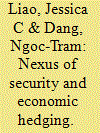

|
|
|
|
|
| Summary/Abstract |
Hedging has been a widely discussed concept in explaining East Asian states’ counteracting policies in the face of great power competition. However, the current literature has yet to specify how hedging responds to great power competition in economic statecraft, namely, using economic means to influence other states. This paper examines Vietnam’s response to Japan and China’s infrastructure financing programs over the past three decades. Through a combination of quantitative and qualitative data, it explains how Vietnam, while following economic pragmatism, does not simply aim to maximize gains from these two powers. Vietnam’s decisions embody what we call economic hedging, or a cautious calculation over the linkage between security risks and infrastructure partnership and a tendency to pivot away from infrastructure partners deemed risky, namely, China. It also shows that such caution has intensified in the face of a nationalistic public that has challenged the notion of economic pragmatism, pushed a realist approach to economic relations with China, and bolstered Hanoi to take more action to protect Vietnamese sovereignty from Chinese economic influence. The convergence of these domestic and international trends have driven Hanoi to enhance collaboration with Japan, which it views as an increasingly important strategic partner.
|
|
|
|
|
|
|
|
|
|
|
|
|
|
|
|
| 11 |
ID:
179744


|
|
|
|
|
| Summary/Abstract |
As part of the sustainable energy transition in Germany, substantial investments in power grid infrastructure are planned. They are intended to provide flexibility to an electricity system increasingly relying on variable renewable energy sources, and on European interconnection. While much research has been done on the benefits of renewables, the economic impact of the necessary grid investments so far remains widely unclear. This paper presents a macroeconomic assessment of the planned investments in power grid infrastructure in Germany. By performing a static input-output analysis, the investigation reveals how multiplier effects of the grid investments impact macroeconomic outcomes – in terms of output, value added, employment and fiscal income. Net multiplier effects on outputs are found to be positive, ranging between €47.3 bn and €55.8 bn, while other effects turn out to be negative. A net decrease in value added of between €10.1 bn and €12.7 bn, in fiscal income between €962 million and €1354 million, and reductions in employment of between 130,170 and 158,940 jobs are found to be attributable to the grid investments. Hence, from a national perspective, the planned investments are found to have mixed macroeconomic effects and are not necessarily 100% 'no-regret'. Flexibility investments for the energy transition provided by power grids should therefore be realized with caution, and at least cost, if negative effects on national value added, tax revenues and employment are to be minimized. For policy guidance, more research is needed on the relative merits of the flexibility options available for accomodating high shares of renewables, and on the overall economic net benefits of sustainable energy transitions.
|
|
|
|
|
|
|
|
|
|
|
|
|
|
|
|
| 12 |
ID:
187812
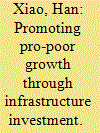

|
|
|
|
|
| Summary/Abstract |
This paper empirically estimates the effects of infrastructure investments on the level and distribution of impoverished households' income, utilizing the arguably exogenous investment shock from the Targeted Poverty Alleviation program in China. We focus on the agricultural income of poor rural households. We also examine whether these infrastructure investments increase or decrease income inequality within the impoverished group. We distinguish among different types of infrastructure investment, aiming to identify the investments effective in promoting growth in agricultural income, especially for the poorest. Based on a comprehensive household-level administrative dataset and econometric analysis, we find that electricity infrastructure significantly increases poor households' agricultural income and that the income benefit is equally distributed among the poor; agricultural irrigation infrastructure raises agricultural income significantly and delivers more benefit to the poorest households. An examination of the mechanism shows that both electricity and irrigation infrastructure increase the probability of participating in agricultural work and therefore increase agricultural income. These findings imply that, through increasing the utilization of agricultural land and the labor of impoverished households, electricity and irrigation infrastructure investments in rural impoverished areas are likely to lead to pro-poor and sustainable development.
|
|
|
|
|
|
|
|
|
|
|
|
|
|
|
|
| 13 |
ID:
178697
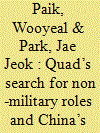

|
|
|
|
|
| Summary/Abstract |
The Quadrilateral Security Dialogue (‘Quad’)—a cooperative consisting of the US, Japan, Australia, and India—has re-emerged since 2017 after a decade of dormancy. After typologizing the minilateral security cooperation’s goals and its expansion, this article explains that the current Quad is an expanded minilateral cooperation of the existing various security bilaterals and trilaterals among its member states. This minilateral has increased its non-military cooperation, focusing on infrastructure-building to counter that of China’s Belt and Road Initiative in the Indo-Pacific region. It also examines how China has been responding to this line of the Quad’s economic responses, while China is cautious about the Quad’s security implications. It concludes with some predictions as to how this set of interactions is likely to influence the regional order.
|
|
|
|
|
|
|
|
|
|
|
|
|
|
|
|
|
|
|
|
|